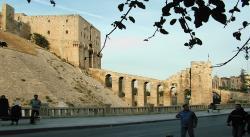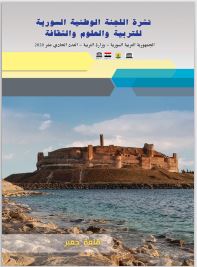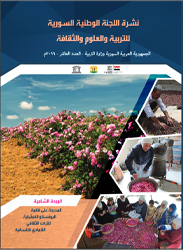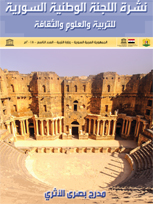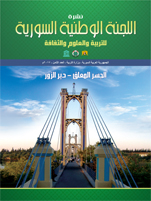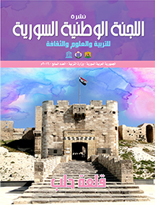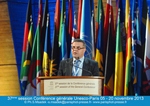Old Aleppo City
|
- Located at the crossroads of several trade routes from the 2nd millennium B.C., Aleppo was ruled successively by the Hittites, Assyrians, Arabs, Mongols, Mamelukes and Ottomans. The 13th-century citadel, 12th-century Great Mosque and various 17th-century madrasas, palaces, caravanserais and hammams all form part of the city's cohesive, unique urban fabric, now threatened by overpopulation.
- Located at the crossroads of several trade routes since the 2nd millennium B.C., Aleppo was ruled successively by the Hittites, Assyrians, Akkadians, Greeks, Romans, Umayyads, Ayyubids, Mameluks and Ottomans who left their stamp on the city. The Citadel, the 12th-century Great Mosque and various 16th and 17th-centuries madrasas, residences, khans and public baths, all form part of the city's cohesive, unique urban fabric. - The monumental Citadel of Aleppo, rising above the suqs, mosques and madrasas of the old walled city, is testament to Arab military might from the 12th to the 14th centuries. With evidence of past occupation by civilizations dating back to the 10th century B.C., the citadel contains the remains of mosques, palace and bath buildings. The walled city that grew up around the citadel bears evidence of the early Graeco-Roman street layout and contains remnants of 6th century Christian buildings, medieval walls and gates, mosques and madrasas relating to the Ayyubid and Mameluke development of the city, and later mosques and palaces of the Ottoman period. Outside the walls, the Bab al-Faraj quarter to the North-West, the Jdeide area to the north and other areas to the south and west, contemporary with these periods of occupation of the walled city contain important religious buildings and residences. - Fundamental changes to parts of the city took place in the 30 years before inscription, including the destruction of buildings, and the development of tall new buildings and widened roads. Nonetheless the surviving ensemble of major buildings as well as the coherence of the urban character of the suqs and residential streets and lanes all contribute to the Outstanding Universal Value. Criterion (iii): The old city of Aleppo reflects the rich and diverse cultures of its successive occupants. Many periods of history have left their influence in the architectural fabric of the city. Remains of Hittite, Hellenistic, Roman, Byzantine and Ayyubid structures and elements are incorporated in the massive surviving Citadel. The diverse mixture of buildings including the Great Mosque founded under the Umayyads and rebuilt in the 12th century; the 12th century Madrasa Halawiye, which incorporates remains of Aleppo's Christian cathedral, together with other mosques and madrasas, suqs and khans represents an exceptional reflection of the social, cultural and economic aspects of what was once one of the richest cities of all humanity. - Criterion (iv): Aleppo is an outstanding example of an Ayyubid 12th century city with its military fortifications constructed as its focal point following the success of Salah El-Din against the Crusaders. The encircling ditch and defensive wall above a massive, sloping, stone-faced glacis, and the great gateway with its machicolations comprise a major ensemble of military architecture at the height of Arab dominance. Works of the 13th-14th centuries including the great towers and the stone entry bridge reinforce the architectural quality of this ensemble. Surrounding the citadel within the city are numerous mosques from the same period including the Madrasah al Firdows, constructed by Daifa Khatoun in 1235. - The boundary of the property follows the line of the walls of the old city and three extra-muros areas: North, Northeast and East suburbs. Some attributes exist beyond the boundary and need protection by a buffer zone. - Although the Citadel still dominates the city, the eight storey hotel development in the Bab al-Faraj area has had a detrimental impact on its visual integrity, as have other interventions before inscription. The remaining coherence of the urban fabric needs to be respected and the vulnerabilities of fabric and archaeological remains, though lack of conservation, need to be addressed on an on-going basis. Authenticity (2009) - Since inscription, the layout of the old city in relation to the dominant Citadel has remained basically unchanged. Conservation efforts within the old city have largely preserved the attributes of the Oustanding Universal Value. However the setting is distinctly vulnerable due to the lack of control mechanisms in the planning administration, including the absence of a buffer zone. The historic and traditional handicraft and commercial activities continue as a vital component of the city sustaining its traditional urban life. - Protection and management requirements (2009) The property is protected by the Antiquities Law administered by the Directorate of Antiquities and Museums (DGAM). - In 1992, the Project for the Rehabilitation of Old Aleppo was set up under the Municipality of Aleppo in cooperation with international agencies. In 1999, the Directorate of the Old City was established under the Municipality of Aleppo to guide the rehabilitation of the old city with three departments covering studies and planning; permits and monitoring, and implementation and maintenance. A comprehensive plan for the evolution of the city is being prepared by the Old City Directorate office. The city's development is being considered under the 'Programme for Sustainable Urban Development in Syria' (UDP), a joint undertaking between international agencies, the Syrian Ministry for Local Administration and Environment, and several other Syrian partner institutions. The programme promotes capacities for sustainable urban management and development at the national and municipal level, and includes further support to the rehabilitation of the Old City. - There is an on-going need to foster traditional approaches to conservation, restoration, repair and maintenance of building fabric. There is also a need for an overall conservation management plan to include planning rules for heights and density of new developments in specific neighbourhoods, and for policies for the protection of archaeological remains uncovered during infrastructure and development works. There is also a need for an approved buffer zone with appropriate planning constraints. Long Description - Aleppo has exceptional universal value because it represents medieval Arab architectural styles that are rare and authentic, in traditional human habitats. It constitutes typical testimony of the city's cultural, social, and technological development, representing continuous and prosperous commercial activity from the Mameluke period. It contains vestiges of Arab resistance against the Crusaders, but there is also the imprint of Byzantine, Roman and Greek occupation in the streets and in the plan of the city. - Located 350 km north of Damascus at the crossroads of several trade routes, Aleppo was very prosperous from the 3rd millennium BC, a prosperity it preserved throughout its evolution and its settlement. The old city was surrounded by a defensive enclosure, flanked by towers and entered by fortified gates from the Islamic era. Aleppo is famous for its mosques, madrasas (the Fardos Madrassa is one of the outstanding religious buildings) and churches. It is still a very active Arab commercial city. Aleppo has a jumble of houses in the subtlest pastel colours with slender minarets and, dominating it all, the great mass of the Citadel. The southern ramparts, partly cleared of houses, lead to the impressive of all the fortified gates, Bab Qinnesrin. - The al Gassa- skirts the Jdeideh, 'old houses' quarter, with its beautifully decorated courtyards. All the houses here are built from fine limestone, lining narrow streets without shops and sometime vaulted. This lead through the souks, covered by vaulted roofs. The al Joumrok khan (Customs Caravanserai) dates from the 17th century: French, English, and Dutch merchants traded here and their consuls were obliged to live here. In a corner a staircase leads up to a private house which was the Venetian consulate from the 15th to the 19th century when it became the residence of the Belgian consul; at the present time the house conserves its typically Venetian style. Over many generations men of taste have built up a priceless collection of works of art from every country between China and. - The Jami al Kabir entrance (Umayyad or Great Mosque) is opposite an old Koranic school, the al Halawyah Madrassa, installed in the former Byzantine cathedral erected at the command of the Empress Helena. The Great Mosque was founded in the early Islamic period, but there is little to see that dates from that time. The Mameluke minaret dates from 1090 and is, with its fine proportions and Kufic inscriptions, a good example of the great period of Islamic architecture in Syria. The north facade is one side of the square. - A ring of crenellated walls and towers rises rise 50m above the city from a steep glacis, encircling a mass of ruins of every period. The nail-heads on the doors themselves are beautifully worked, the lintels have comic or enigmatic carvings on them, and there are fine Kufic inscriptions calling upon the power and the mercy of Allah. The interior of the citadel shows all too clearly how it has been ravaged by enemies (the Mongols invaded it twice) and shattered by earthquakes (that of 1822 was particularly devastating). - St George's Cathedral stands behind a labyrinth of narrow streets on a tiny square. The postern gate in the middle of the ramparts (Bab Antakia) is the Antioch Gate. Beyond there are many important monuments - the little domed Byzantine church converted into a mosque; a prison with dungeons dug into the rock; a stretch of wall 4 m thick, the base of a Syrio-Hittite temple; the remains of a great mosque built by Saladin's son; a covered building containing sculpture and objects from various periods found on the site; the tomb of Emir Zaher Ghazi (son of Saladin) in an annex to a madrasa founded during the Crusader period. - The 13th century royal palace, with its fine stalactite and honeycomb entrance porch, is inlaid with white marble. The throne room, dating from the Mameluke period (15th-16th centuries) has been tastefully restored: Syrian artists and craftsmen have recreated the luxurious setting of the court - the ceiling with its decorated beams and caissons, lighting, windows, polychrome columns - all are a tribute to their skill. There are around 200 minarets, some squat like defensive towers, others slender as needles. On the other side stands a fine octagonal, part of the 15th century al Atroush mosque. |
View Album / old Aleppo City











